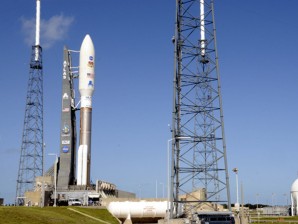NASA in high gear for Mars rover launch

MARS ROVER LAUNCH. NASA’s Mars Science Laboratory on Nov. 25, 2011 is contained in a fairing that sits atop an Atlas 5 rocket on launch pad 41 at Cape Canaveral, Florida, as final preparations are made for its November 26 launch. The Mars Science Lab in expected to land on Mars early August 2012. AFP.
CAPE CANAVERAL – The US space agency plans to launch on Saturday the most powerful and advanced robotic rover ever built to explore Mars and hunt for signs that life may once have existed on the red planet.
The Mars Science Laboratory, an elite six-wheeled vehicle powered by nuclear fuel, is scheduled to launch at 10:02 a.m. (1502 GMT) from Cape Canaveral Air Force Station in Florida atop an Atlas V rocket.
“This is a Mars scientist’s dream machine,” Ashwin Vasavada, MSL deputy project scientist at NASA’s Jet Propulsion Laboratory, told reporters.
“This is the most capable scientific explorer we have ever sent out… We are super excited.”
At a price of $2.5 billion, the rover, also known as Curiosity, aims to provide scientists with detailed information about the rocks on the surface of Mars, and clues about whether life ever existed on Earth’s nearest neighbor.
Article continues after this advertisementTo do that, the SUV-sized rover is equipped with a robotic arm, a drill, a set of 10 science instruments including two color video cameras, a laser beam for zapping interesting rocks and a tool kit for analyzing their contents.
Article continues after this advertisementIf all goes as planned and Curiosity lands intact in about nine months, on Aug. 5, 2012, the rover will be able to report back to scientists on what it finds without ever bringing the rock samples back to Earth.
NASA’s exploration of Mars began with the 1976 landing of the Viking spacecraft and has continued with, most recently, the twin rovers known as Spirit and Opportunity that began tooling around on the Martian surface in 2004. Spirit finally died last year, but Opportunity is still working.
NASA sees Curiosity as the midway point in a long journey of Mars discovery that may lead to a human mission there, or to one of its two moons, in the 2030s.
Any clues Curiosity can send back about the habitability of the fourth planet from the Sun, and about the radiation levels there will be important to NASA as it devises future exploration missions.
The landing spot for Curiosity, the Gale Crater near Mars’ equator, was chosen after lengthy study because it contains a three-mile high mountain and many layers of sediment that could reveal a lot about the planet’s wetter past.
“We are basically reading the history of Mars’ environmental evolution,” said John Grotzinger, project scientist for Mars Science Laboratory at the California Institute of Technology.
“We start at the bottom where the clays are, we go to the sulfates, and we come up and go to the top of the mound and get rocks we think were formed in largely non-water bearing environments representing the drier, more recent phase of Mars.”
The crater itself is at a low elevation so scientists believe that if water ever did pool on Mars, it likely found its way there and may have left behind traces of life.
Everywhere that water exists on Earth, so does some form of life. So scientists are hopeful that they may find more than just hints that life used to thrive there – perhaps even signs that microbial life still does.
“It is going to look for places that are habitable either in the past or potentially even in the future or currently,” said Mary Voytek, director, NASA Astrobiology Program.
First, the rover has to travel a journey of 354-million-mile (570-million-kilometer), arrive intact and survive an elaborate rocketed-powered sky crane landing.
The project is meant to last two Earth years, or one full Martian year, but NASA hopes that like some of its other rovers in the past, Curiosity will outlive its expected potential.
“Viking did the best it could, but it could only see a couple of samples. MSL is going to look at tons of samples,” said Pamela Conrad, deputy principal investigator of sample analysis at Mars.
Her experiment, a set of three spectrometers, is “designed to not only sniff the atmosphere and look for volatile species but to evolve gases from solid samples and then sniff those gases that come out,” she said.
“Mars very easily could have produced life. Mars could very easily have evolved the complex chemistry that is necessary to be a habitable environment. And that information is still on Mars.”